check engine CHEVROLET S10 1994 2.G Workshop Manual
[x] Cancel search | Manufacturer: CHEVROLET, Model Year: 1994, Model line: S10, Model: CHEVROLET S10 1994 2.GPages: 340, PDF Size: 18.45 MB
Page 282 of 340
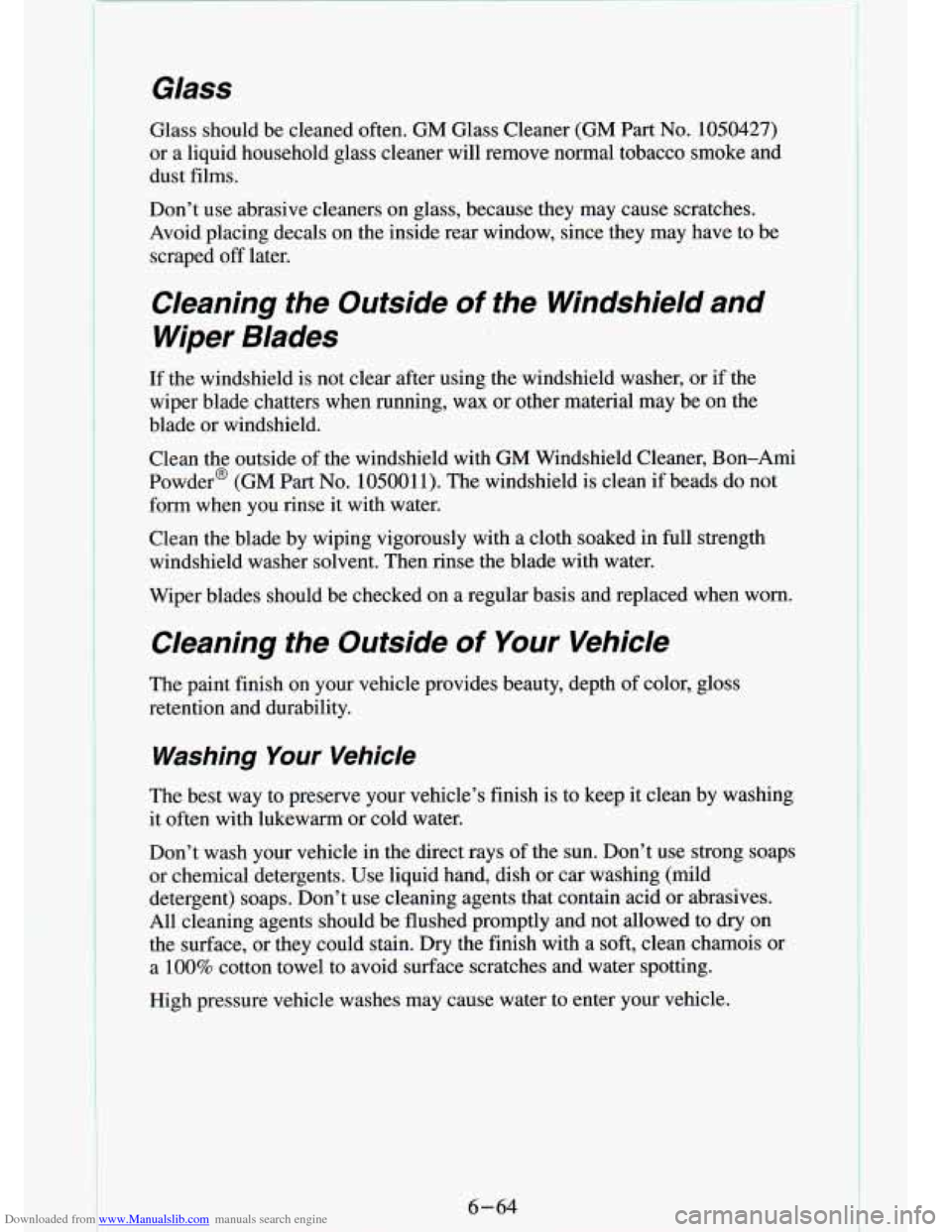
Downloaded from www.Manualslib.com manuals search engine Glass
Glass should be cleaned often. GM Glass Cleaner (GM Part No. 1050427)
or a liquid household glass cleaner will remove normal tobacco \
smoke and
dust films.
von’t use abrasive cleaners on glass, because they may cause scratches.
Avoid placing decals on the inside rear window, since they may have to be
scraped
off later.
Cleaning the Outside of the Windshield and
Wiper Blades
If the windshield is not clear after using the windshield washer, or \
if the
wiper blade chatters when running, wax or other material may b\
e on the
blade or windshield.
Clean the outside
of the windshield with GM Windshield Cleaner, Bon-Ami
Powder@ (GM Part
No. 1050011). The windshield is clean if beads do not
form when you rinse it with water.
Clean the blade by wiping vigorously with a cloth soaked in full strength
windshield washer solvent. Then rinse the blade with water.
Wiper blades should be checked on a regular basis and replaced\
when worn.
Cleaning the Outside of Your Vehicle
The paint finish on your vehicle provides beauty, depth of color, gloss
retention and durability.
Washing Your Vehicle
The best way to preserve your vehicle’s finish is to keep it clean by washing
it often with lukewarm or cold water.
Don’t wash your vehicle
in the direct rays of the sun. Don’t use strong soaps
or chemical detergents. Use liquid hand, dish or car washing (\
mild
detergent) soaps. Don’t use cleaning agents that contain aci\
d or abrasives.
All cleaning agents should be flushed promptly and not allowed \
to dry on
the surface, or they could stain. Dry the finish with a soft,\
clean chamois or
a
100% cotton towel to avoid surface scratches and water spotting.
High pressure vehicle washes may cause water to enter your vehicle.
.L 1
-. L .I . -0
-, I-
6-64
Page 289 of 340
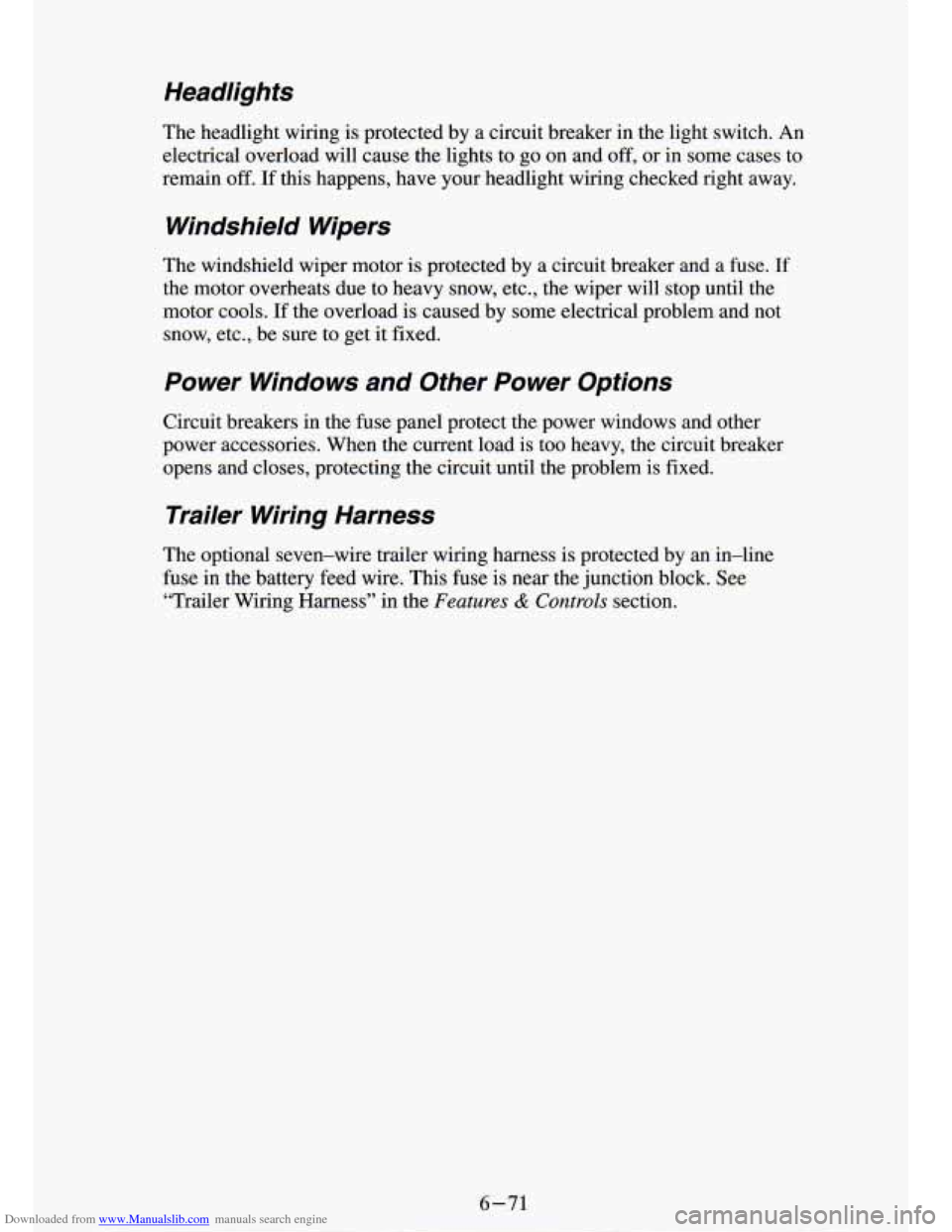
Downloaded from www.Manualslib.com manuals search engine Headlights
The headlight wiring is protected by a circuit breaker in the light switch. An
electrical overload will cause the lights to go on and off, or in some cases to
remain
off. If this happens, have your headlight wiring checked right away.
Windshield Wipers
The windshield wiper motor is protected by a circuit breaker and a fuse. If
the motor overheats due to heavy snow, etc., the wiper will stop until .the
motor cools. If the overload is caused by some electrical problem and not
snow, etc., be sure to get it fixed.
Power Windows and Other Power Options
Circuit breakers in the fuse panel protect the power windows and other
power accessories. When the current load is too heavy, the circuit breaker
opens and closes, protecting the circuit until the problem is fixed.
Trailer Wiring Harness
The optional seven-wire trailer wiring harness is protected by an in-line
fuse in the battery feed wire. This fuse
is near the junction block. See
“Trailer Wiring Harness”
in the Features & Controls section.
Page 291 of 340
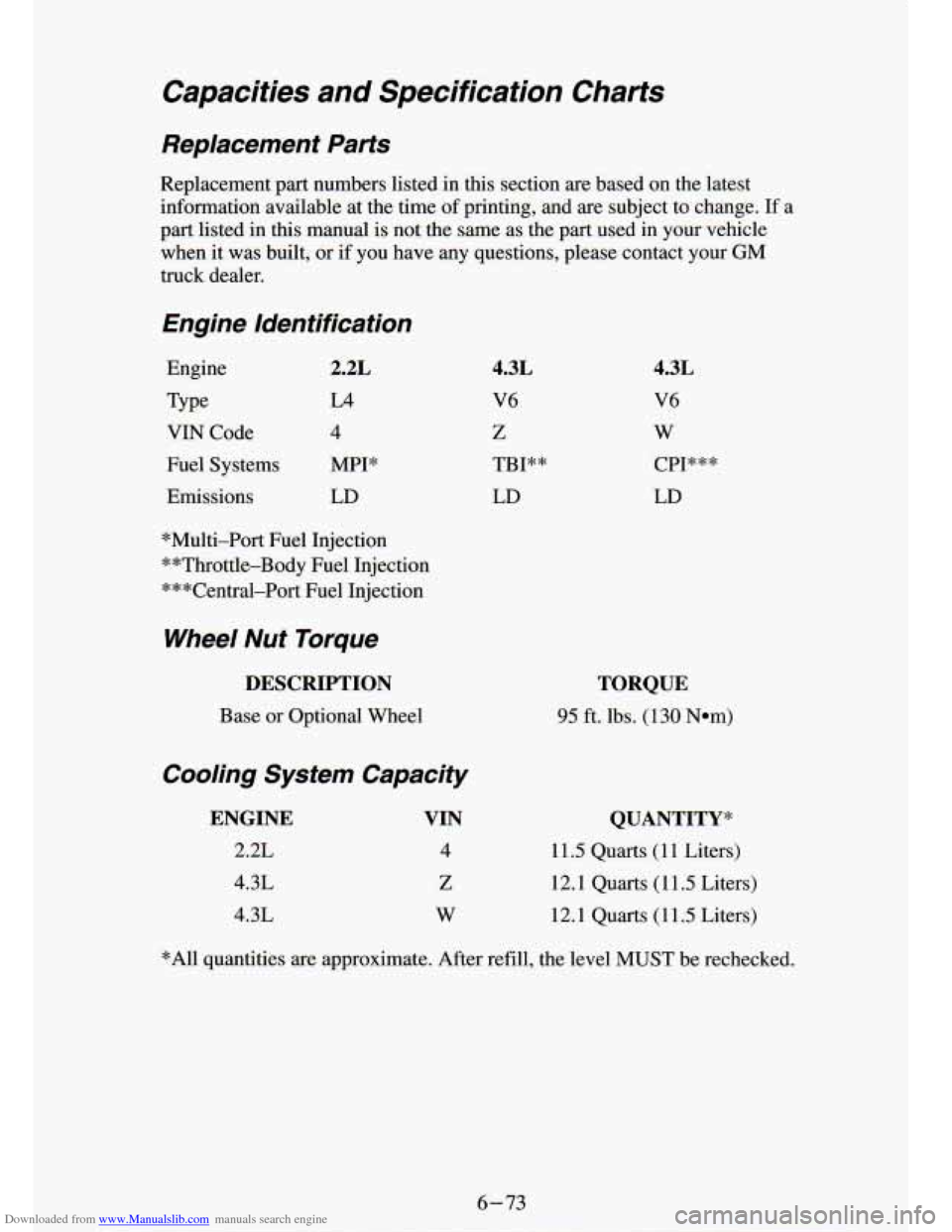
Downloaded from www.Manualslib.com manuals search engine Capacities and Specification Charts
Replacement Parts
Replacement part numbers listed in this section are based on the latest
information available at the time of printing,
and are subject to change. If a
part listed
in this manual is not the same as the part used in your vehicle
when it
was built, or if you have any questions, please contact your GM
truck dealer.
Engine Identification
Engine
Type
VZN Code
Fuel Systems
Emissions
2.2L
L4
4
MPI* LD
*Multi-Port Fuel Injection
**Throttle-Body Fuel Injection
***Central-Port Fuel Injection
Wheel Nut Torque
DESCRIPTION
Base or Optional Wheel
Cooling System Capacity
ENGINE VIN
2.2L 4 4.3L
Z
4.3L w
4.3L
V6
Z
TBI**
LD
4.3L
V6
W
CPI* * *
LD
TORQUE
35 ft. lbs. (130 Nom)
QUANTITY*
11.5 Quarts (1 1 Liters)
12.1 Quarts (11.5 Liters)
12.1 Quarts (11.5 Liters)
*All quantities are approximate. After refill, the level
MUST be rechecked.
6-73
Page 292 of 340

Downloaded from www.Manualslib.com manuals search engine Crankcase Capacity
ENGINE VIN
2.2L
4.3L
4.3L 4
z
W
QUANTITY QUANTITY WITH
WITHOUT FILTER* FILTER*
4 Quarts (3.8 Liters) 4.5 Quarts (4.3 Liters)
4 Quarts.(3.8 Liters) 4.5 Quarts (4.3 Liters)
4 Quarts (3.8 Liters) 4.5 Quarts (4.3 Liters)
*All quantities are approximate. After refill, the level MUST be rechecked.
Fuel Tank Capacity
TYPE
Standard Tank
*All quantities are approximate.
Lamp and Bulb Data
LAMPS
EXTERIOR
Headlamps (Sealed Beam)
Headlamps (Composite)
Backup Lamp
License Lamp
(w/o Bumper)
License Lamp (Step Bumper) Tail and Stop Lamps Marker Lamp-Front
Marker Lamp-Rear
Parking and Signal Lamp
Underhood Lamp
CHMSL?$
?Standard Cluster
$Tach Cluster
QUANTITY*
20 Gallons (76 Liters.)
QUANTITY TRADE NO.
2
2
2
2
2
2
1
2 2E1H
H9005
(HI)
H9006 (LO) 3057
194
194
3057 194
194
3 157NA
93
577
6.- 74
I
Page 293 of 340

Downloaded from www.Manualslib.com manuals search engine INTERIOR
Ash Tray Lamp
Courtesy Lamp
Dome Lamp
Fol -Wheel Drive - lit, lr
Hearer & A/C Controi
Instrument Panel Compartment Lamp
Rearview Mirror Lamps Sunshade Vanity Mirror Lamps 1
2 1
4 161
906
211-2 161
37
1003
2 12-2
74
INSTRUMENT CLUSTER LAMPS NOTE:
A PC part number indicates that the bulb and base are one
assembly
and must be replaced as such.
LAMPS QUANTITY
TRADE NO.
Anti-lock Brake Warning Indicator ?$
Brake System Warning Indicator?$
Check Gages Indicator?$
Daytime Running Lamps Indicator?$
Charging System Indicator?$ High Beam Indicator?$
Standard Cluster Illumination?
Tach Cluster Illumination$
Malfunction Indicator Lamp (Service
Engine
Soon)?$
Seat Belt Indicator?$
Turn Signal Indicator?
Upshift Indicator?$
?Standard Cluster
$Tach Cluster 1
1
1
1
1
1
4
1
4
1
1
PC74
PC74
PC74
PC74
PC74
PC74
PC 194 and
PC119
PC194 and
GE 194
PC74
PC74
PC74
PC74
Page 297 of 340

Downloaded from www.Manualslib.com manuals search engine Scheduled Maintenance Services
Section
.
This section covers the maintenance required €or your vehicle . Your vehicle
needs these services to retain its safety. dependability. and emission control
performance
.
A Word About Maintenance .................................. 7-2
Your Vehicle and the Environment
............................. 7-2
Scheduled Maintenance Services
............................... 7-3
Selecting The Proper Maintenance Schedule
................... 7-3
Maintenance Schedule
I ................................ 7-4
Maintenance Schedule
I1 ................................ 7-6
Explanation
of Scheduled Maintenance Services ................ 7-7
Owner Checks and Services
.................................. 7-10
At Least Once a Month
................................... 7-10
At Least Four Times a Year
............................... 7-10
AtLeastOnceaYear
.................................... 7-10
Periodic Maintenance Inspections
............................. 7-12
Recommended Fluids
& Lubricants ........................... 7-13
Maintenance Record
....................................... 7-15
Service Station Checks
..................................... 7-16
Have you purchased the GM Protection Plan? The Plan supplements\
your new vehicle warranties
. See your GM dealer for details .
7-1
Page 298 of 340
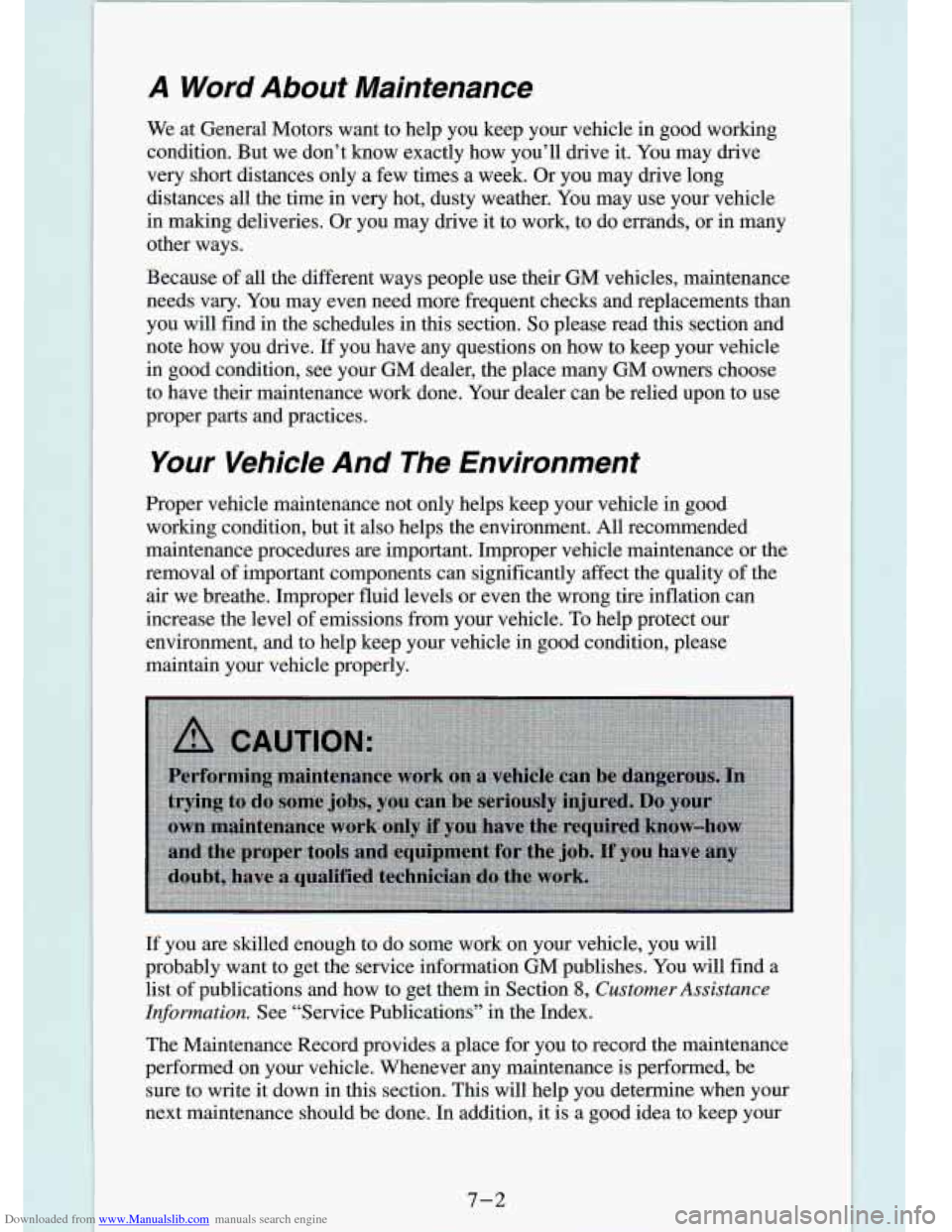
Downloaded from www.Manualslib.com manuals search engine A Word About Maintenance
We at General Motors want to help you keep your vehicle in good \
working
condition. But we don’t know exactly how you’ll drive it. You may drive
very short distances only a few times a week. Or you may drive long
distances all the time
in very hot, dusty weather. You may use your vehicle
in making deliveries. Or you may drive it to work, to do errands, or in many
other ways.
Because of all the different ways’pWple use their GM vehicle\
s, maintenance
needs vary. You may even need more frequent checks and replacements than
you will find in the schedules in this section.
So please read this section and
note how you drive. If you have any questions on how to keep your vehicle
in good condition, see your GM dealer, the place many GM owners \
choose
to have their maintenance work done. Your dealer can be relied up\
on to use
proper parts and practices.
Your Vehicle And The Environment
Proper vehicle maintenance not only helps keep your vehicle in good
working condition, but it also helps the environment. All recommended
maintenance procedures
are important. Improper vehicle maintenance or the
removal of important components can significantly affect the quality of the\
air we breathe. Improper fluid levels or even the wrong tire infla\
tion can
increase the level
of emissions from your vehicle. To help protect our
environment, and to help keep your vehicle in good condition, \
please
maintain your vehicle properly.
If you are skilled enough to do some work on your vehicle, you
will
probably want to get the service information GM publishes. You will find a
list of publications and how to get them in Section
8, Customer Assistance
Information.
See “Service Publications” in the Index.
The Maintenance Record provides a place for you to record the maintenance
performed on your vehicle. Whenever any maintenance is performed\
, be
sure
to write it down in this section. This will help you determine when your
next maintenance should be done. In addition, it is a good idea to keep your
7-2
Page 303 of 340

Downloaded from www.Manualslib.com manuals search engine Explanation Of Scheduled Maintenance Services
Below are explanations of the services listed in the maintenance charts.
The proper fluids and lubricants to use are listed
in this section. Make sure
whoever services your vehicle uses these. All parts should be \
replaced and
all necessary repairs done before you or anyone else drives the vehicle.
1. ENGINE OIL AND OIL FILTER CHANGE* - ALWAYS USE
API SERVICE SH OR SG ENERGY CONSERVING I1 OILS
OF THE
PROPER VISCOSITY. The “SH” or
“SG’ designation may be shown
alone or in combination with others, such as “SWCD”, or
“SH, SG,
CD,” or “SGKD”, etc. To determine the preferred viscosity oil for your
vehicle’s engine (e.g. SAE 5W-30), see “Engine
Oil” in the Index.
2. CHASSIS LUBRICATION - Lubricate the front suspension, ball
joint, steering linkage, and transfer case shift linkage, parking brake\
cable guides, propshaft splines, universal joints, brake pedal springs,
and clutch pedal springs at the intervals specified on the proper
maintenance schedule, or at every engine oil change, whichever comes
first
.
Ball joints should not be lubricated unless their temperature is 10°F
(-12°C) or higher. When the weather is cold, let them warm up before
lubricating them or they could be damaged.
Also, be sure
to check all the vehicle fluid levels at this time.
3.
COOLING SYSTEM SERVICE* - Drain, flush and refill the
system with new or approved recycled coolant conforming to “\
GM
Specification 6038-M” (4.3L engine) or “GM Specification 6043-M”
(2.2L engine). See “Engine Coolant” in the Index for the proper coolant
and mixture to use in your vehicle.
Also inspect the hoses and replace them if they are cracked, \
swollen, or
deteriorated. Clean the outside of the radiator and air conditioning
condenser. Wash the radiator neck. To ensure proper operation,
pressure test the radiator and cap.
4. AIR CLEANER FILTER REPLACEMENT* - Replace at
specified intervals. Ask your dealer for the proper replacement
intervals for your driving conditions.
5. FRONT WHEEL BEARING REPACK (%WHEEL DRIVE
ONLY) - Clean and repack the front wheel bearings at each brake
relining, or at the specified interval, whichever comes first.
*An Emission Control Service
7-7
Page 304 of 340

Downloaded from www.Manualslib.com manuals search engine 6. TRANSMISSION SERVICE:
Automatic Transmission
- Change the transmission fluid and filter
every
15,000 miles (25 000 km) he vehicle is mainly driven under
one or more of these conditions:
0 In heavy city traffic.
0 Where the outside temperature regularly reaches 90°F (32°C) or
0 In hilly or mountainous terrain.
0 Frequent trailer pulling. higher.
Uses such as taxi, police, delivery or other commercial service\
.
If the vehicle is not used mainly under any of these conditions, change
the fluid and filter every
30,000 miles (50 000 km). See “Automatic
Transmission Fluid” in the Index for more information.
Manual Transmission - Transrnission fluid does not require periodic
changing.
specified interval or sooner if clogged.
7. FUEL FILTER REPLACEMENT* - Replace the fuel filter at the
8. SPARK PLUG REPLACEMENT*$ - Replace spark plugs with the
type listed
in Section 6. Spark plugs (AC908) for the 2.2L Engine (VIN
Code 4) should be replaced every 100,000 miles (166 000 kilometers).
Spark plugs (.CR43TSM) for the 4.3L engines
(VIN Codes W and Z)
should be replaced every 30,000 miles (50 000 kilometers). See
‘‘Specification Charts” in the Index.
9. SPARK PLUG WIRE INSPECTION* - Clean wires and inspect
for burns, cracks or other damage. Check the wire boot fit at the
distributor and at the spark plugs. Replace wires as needed.
Adjust timing to underhood label specifications. Inspect the ins\
ide and outside
of the distributor cap and rotor for cracks, carbon tracking and
corrosion. Clean or replace as needed.
10. ENGINE TIMING CHECK AND DISTRIBUTOR CHECK*$ -
*An Emission Control Service
$=The California Air Resources Board has detennined that the fa\
ilure to
perform this maintenance item will not nullify the emission war\
ranty or limit recall liability prior to the completion
of vehicle usefui life. General
Motors, however, urges that all recommended maintenance services \
be
performed at the indicated intervals and the maintenance be rec\
orded.
7-8
Page 306 of 340
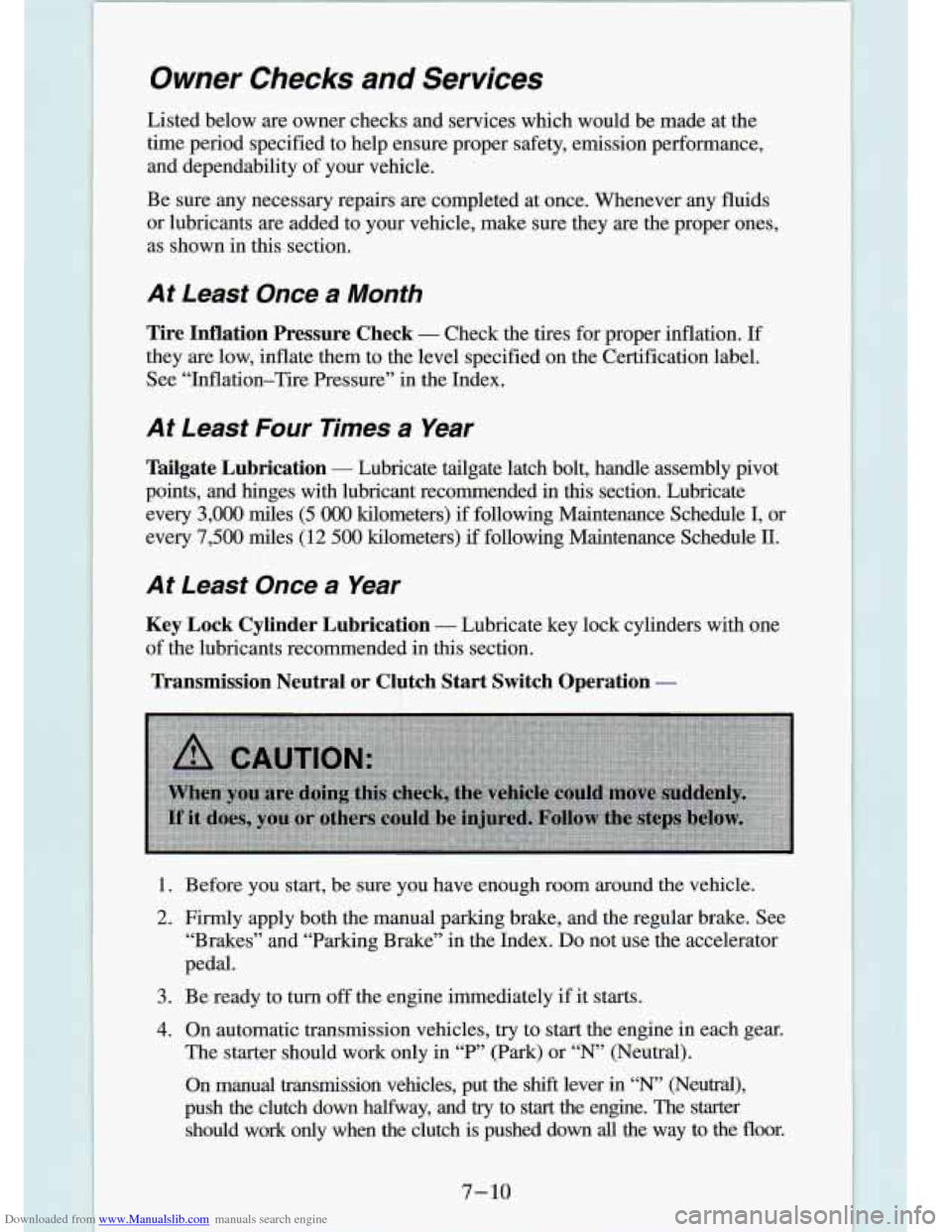
Downloaded from www.Manualslib.com manuals search engine Owner Checks and Services
Listed below are owner checks and services which would be made\
at the
time period specified to help ensure proper safety, emission pe\
rformance,
and dependability
of your vehicle.
Be sure any necessary repairs
are completed at once. Whenever any fluids
or lubricants are added to your vehicle, make sure they are t\
he proper ones,
as shown in this section.
At Least Once a Month
Tire Inflation Pressure Check - Check the tires for proper inflation. If
they
are low, inflate them to the level specified on the Certification \
label.
See “Inflation-Tire Pressure” in the Index.
At feast Four Times a Year
Tailgate Lubrication - Lubricate tailgate latch bolt, handle assembly pivot
points, and hinges with lubricant recommended in
this section. Lubricate
every
3,000 miles (5 000 kilometers) if following Maintenance Schedule I, or
every
7,500 &les (12 500 kilometers) if following Maintenance Schedule II.
At Least Once a Year
Key Lock Cylinder Lubrication - Lubricate key lock cylinders with one
of the lubricants recammended in
this section.
Transmission Neutral or Clutch Start Switch Operation -
1.
2.
3.
4.
Before you start, be sure you have enough room around the veh\
icle.
Firmly apply both the manual parking brake, and the regular br\
ake. See
“Brakes” and “Parking Brake” in the Index.
Do not use the accelerator
pedal.
Be ready to
turn off the engine immediately if it starts.
On automatic transmission vehicles,
try to start the engine in each gear.
The starter should work only in
T“ (Park) or “N’ (Neutral).
On manual transmission vehicles, put the shift lever in “N’ (Neutral),
push the clutch down halfway, and
try to start the engine. The starter
should work only when the clutch is pushed down
all the way to the floor.
7-10